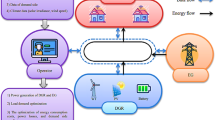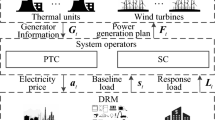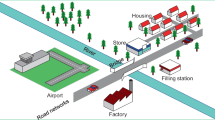Abstract
Generation expansion planning (GEP) is a pivotal problem for power system planners due to increasing electric power consumption. This article aims to construct a methodology for GEP in power networks while incorporating the prohibited operating zones (POZ) and multi-fuel option (MFO) into the problem. The POZ and MFO are not considered in the existing GEP models, whereas these factors might considerably change the optimal planning scheme. A decentralized framework that relies on a generalized Nash equilibrium problem (GNEP) is considered in this paper, where several rival generation companies (Gencos) compete with each other to specify their own optimal decisions. Due to modeling the POZ and MFO in the GEP problem, integer variables are introduced, leading to a discretely constrained GNEP (DC-GNEP). Employing Karush–Kuhn–Tucker (KKT) optimality conditions, the DC-GNEP is recast as mixed-integer linear programming, which commercial branch-and-cut solvers can efficiently solve. Numerical experiments are performed on the IEEE 118-bus system to analyze and compare optimal GEP solutions. The numerical results point to the effectiveness of the proposed model considering POZ and MFO.





Similar content being viewed by others
Availability of data and materials
Not applicable.
Abbreviations
- \(f\) :
-
Index for fuel types.
- g :
-
Index for generators.
- G :
-
Index for Gencos.
- \(i, j\) :
-
Index for buses.
- \(ij\) :
-
Index for transmission line connected to buses i and j.
- \(z\) :
-
Index for operating zones.
- \({\Omega }^{G},{\Omega }^{-G}\) :
-
Set of all Gencos and set of all Genco except Genco G.
- \({\Omega }_{g}^{F}\) :
-
Set of fuel types used by generator g.
- \({\Omega \mathrm{g}}_{i}^{e},{\Omega \mathrm{g}}_{i}^{c}\) :
-
Set of all existing and candidate generators connected to bus i.
- \({\Omega \mathrm{g}}^{e},{\Omega \mathrm{g}}^{c}\) :
-
Set of all existing and candidate generators \(\left({\Omega \mathrm{g}}^{e}={\bigcup }_{i\in {\Omega }^{N}}{\Omega \mathrm{g}}_{i}^{e}\right)\) and \(\left({\Omega \mathrm{g}}^{c}={\bigcup }_{i\in {\Omega }^{N}}{\Omega \mathrm{g}}_{i}^{c}\right)\).
- \({\Omega \mathrm{g}}_{G}^{e},{\Omega \mathrm{g}}_{G}^{c}\) :
-
Set of all existing and candidate generators belonging to Genco G.
- \({\Omega }^{L}\) :
-
Set of all lines.
- \({\Omega }^{N}\) :
-
Set of all nodes.
- \({\Omega }_{gf}^{Z}\) :
-
Set of available operating zones when fuel type f of generator g is activated.
- \(A_{i} ,B_{i} ,A,B\) :
-
Coefficients associated with demand functions.
- \(a_{gf}^{e} ,b_{gf}^{e} \) :
-
Generation cost coefficients of existing generator g and fuel type f ($/MWh) and ($/h).
- \(a_{gf}^{c} ,b_{gf}^{c} \) :
-
Generation cost coefficients of candidate generator g and fuel type f ($/MWh) and ($/h).
- \(I_{g}^{{}}\) :
-
Investment cost of generator g ($/MWh).
- \(M_{1} ,M_{2} ,M_{3} ,M_{g}\) :
-
Disjunctive parameters.
- \(P_{\rm gfz}^{\rm Gmin} ,P_{\rm gfz}^{\rm G{\rm max}}\) :
-
Minimum and maximum generation of generator g while operating with fuel type f at zone z (MW).
- \(PL_{ij}^{\rm {\rm max}}\) :
-
Thermal capacity of line ij (MW).
- \(x_{ij}\) :
-
Reactance of line ij (per unit).
- \({a}_{g}^{\prime},{b}_{g}^{\prime}\) :
-
Auxiliary continuous variables used to define the new cost coefficients of generator g ($/MWh) and ($/h).
- \({PD}_{i}\) :
-
Electric demand at bus i in scenario s (MW).
- \({\rm PG}_{g}^{e}, {\rm PG}_{g}^{c}\) :
-
Power production by existing/candidate generator g (MW).
- \({\rm PG}_{\rm gfz}^{e},{\rm PG}_{\rm gfz}^{c}\) :
-
Power production by existing/candidate generator g while using fuel type f at zone z (MW).
- \({\rm PG}_{g}^{c,{\rm max}}\) :
-
Capacity of generator g to be installed.
- \({PL}_{ij}\) :
-
Power flow of line ij (MW).
- \({\mathrm{Pr}}_{G}\) :
-
Profit of Genco G.
- \({TG}^{G},{TG}^{-G}\) :
-
Total generation of Genco G and total generation of all Gencos except Genco G.
- \({u}_{\rm gfz}^{e},{u}_{\rm gfz}^{c}\) :
-
Binary variable that is equal to 1 if existing/candidate generator g is operated with fuel type f at operating zone z.
- \({y}_{g}\) :
-
Binary variable indicating the installation status of generator g. (If generator g is built \({y}_{g}=1\), otherwise \({y}_{g}=0\))
- \(\lambda \) :
-
Electricity price ($/MWh).
- \({\delta }_{i}\) :
-
Voltage angle at node i (rad).
- \({\Pi }_{\rm gfz}^{e},{\Pi }_{\rm gfz}^{c}\) \({\Psi 1}_{g},{\Psi 2}_{\rm gfz},\) \({\Psi 3}_{\rm gfz}\) :
-
Continuous auxiliary variables introduced in the linearization process
References
Pourakbari-Kasmaei M, Lehtonen M, Fotuhi-Firuzabad M, Marzband M, Mantovani JRS (2019) Optimal power flow problem considering multiple-fuel options and disjoint operating zones: a solver-friendly MINLP model. Int J Electr Power Energy Syst 113:45–55. https://doi.org/10.1016/J.IJEPES.2019.05.020
Niknam T, Azizipanah-Abarghooee R, Narimani MR (2012) Reserve constrained dynamic optimal power flow subject to valve-point effects, prohibited zones and multi-fuel constraints. Energy 47:451–464. https://doi.org/10.1016/J.ENERGY.2012.07.053
Moghddas-Tafreshi SM, Shayanfar HA, Saliminia Lahiji A, Rabiee A, Aghaei J (2011) Generation expansion planning in Pool market: a hybrid modified game theory and particle swarm optimization. Energy Convers Manag 52:1512–1519. https://doi.org/10.1016/J.ENCONMAN.2010.10.019
Chuang AS, Wu F, Varaiya P (2001) A game-theoretic model for generation expansion planning: problem formulation and numerical comparisons. IEEE Trans Power Syst 16:885–891. https://doi.org/10.1109/59.962441
Jenabi M, Ghomi SMTF, Smeers Y (2013) Bi-level game approaches for coordination of generation and transmission expansion planning within a market environment. IEEE Trans Power Syst 28:2639–2650. https://doi.org/10.1109/TPWRS.2012.2236110
Jin S, Ryan SM (2013) A tri-level model of centralized transmission and decentralized generation expansion planning for an electricity market—Part I. IEEE Trans Power Syst 29:132–141
Pozo D, Sauma EE, Contreras J (2013) A three-level static MILP model for generation and transmission expansion planning. IEEE Trans Power Syst 28:202–210. https://doi.org/10.1109/TPWRS.2012.2204073
Wang J, Shahidehpour M, Li Z, Botterud A (2009) Strategic generation capacity expansion planning with incomplete information. IEEE Trans Power Syst 24:1002–1010
Haghighi R, Yektamoghadam H, Dehghani M, Nikoofard A (2021) Generation expansion planning using game theory approach to reduce carbon emission: a case study of Iran. Comput Ind Eng 162:107713. https://doi.org/10.1016/J.CIE.2021.107713
Budi RFS, Sarjiya HSP (2021) Multi-level game theory model for partially deregulated generation expansion planning. Energy 237:121565. https://doi.org/10.1016/J.ENERGY.2021.121565
Gbadamosi SL, Nwulu NI (2021) A comparative analysis of generation and transmission expansion planning models for power loss minimization. Sustain Energy, Grids Networks 26:100456. https://doi.org/10.1016/J.SEGAN.2021.100456
Navidi M, Tafreshi SMM, Anvari-Moghaddam A (2020) A game theoretical approach for sub-transmission and generation expansion planning utilizing multi-regional energy systems. Int J Electr Power Energy Syst 118:105758. https://doi.org/10.1016/J.IJEPES.2019.105758
Careri F, Genesi C, Marannino P, Montagna M, Rossi S, Siviero I (2011) Generation expansion planning in the age of green economy. IEEE Trans Power Syst 26:2214–2223. https://doi.org/10.1109/TPWRS.2011.2107753
Zhou Y, Wang L, McCalley JD (2011) Designing effective and efficient incentive policies for renewable energy in generation expansion planning. Appl Energy 88:2201–2209. https://doi.org/10.1016/J.APENERGY.2010.12.022
Scott IJ, Carvalho PMS, Botterud A, Silva CA (2021) Long-term uncertainties in generation expansion planning: implications for electricity market modelling and policy. Energy 227:120371. https://doi.org/10.1016/J.ENERGY.2021.120371
Abdin AF, Caunhye A, Zio E, Cardin MA (2022) Optimizing generation expansion planning with operational uncertainty: a multistage adaptive robust approach. Appl Energy 306:118032. https://doi.org/10.1016/J.APENERGY.2021.118032
Pourmoosavi MA, Amraee T (2021) Low carbon generation expansion planning with carbon capture technology and coal phase-out under renewable integration. Int J Electr Power Energy Syst 128:106715. https://doi.org/10.1016/J.IJEPES.2020.106715
Pourahmadi F, Kazempour J (2021) Distributionally robust generation expansion planning with unimodality and risk constraints. IEEE Trans Power Syst 36:4281–4295. https://doi.org/10.1109/TPWRS.2021.3057265
Schwele A, Kazempour J, Pinson P (2020) Do unit commitment constraints affect generation expansion planning? A scalable stochastic model. Energy Syst 11:247–282. https://doi.org/10.1007/s12667-018-00321-z
Tejada-Arango DA, Morales-España G, Wogrin S, Centeno E (2020) Power-based generation expansion planning for flexibility requirements. IEEE Trans Power Syst 35:2012–2023. https://doi.org/10.1109/TPWRS.2019.2940286
Allahdadi Mehrabadi R, Parsa Moghaddam M, Sheikh-El-Eslami MK (2020) Regulatory-intervented sustainable generation expansion planning in multi-electricity markets. Sustain Cities Soc 52:101794. https://doi.org/10.1016/j.scs.2019.101794
Allahdadi Mehrabadi R, Parsa Moghaddam M, Sheikh-El-Eslami MK (2020) Generation expansion planning in multi electricity markets considering environmental impacts. J Clean Prod 243:118611. https://doi.org/10.1016/j.jclepro.2019.118611
Hu J, Yan Z, Chen S, Xu X, Ma H (2022) Distributionally robust optimization for generation expansion planning considering virtual inertia from wind farms. Electr Power Syst Res 210:108060. https://doi.org/10.1016/j.epsr.2022.108060
Luz T, Moura P, de Almeida A (2018) Multi-objective power generation expansion planning with high penetration of renewables. Renew Sustain Energy Rev 81:2637–2643. https://doi.org/10.1016/j.rser.2017.06.069
Shao C, Shahidehpour M, Ding Y (2020) Market-based integrated generation expansion planning of electric power system and district heating systems. IEEE Trans Sustain Energy 11:2483–2493. https://doi.org/10.1109/TSTE.2019.2962756
Vrionis C, Tsalavoutis V, Tolis A (2020) A generation expansion planning model for integrating high shares of renewable energy: a meta-model assisted evolutionary algorithm approach. Appl Energy 259:114085. https://doi.org/10.1016/j.apenergy.2019.114085
Kim D, Ryu H, Lee J, Kim K-K (2022) Balancing risk: Generation expansion planning under climate mitigation scenarios. Eur J Oper Res 297:665–679. https://doi.org/10.1016/j.ejor.2021.06.001
LyriodeOliveira L, deOliveira RC, Qadrdan M (2022) Analysis of electricity supply and demand intra-annual dynamics in Brazil: a multi-period and multi-regional generation expansion planning model. Int J Electr Power Energy Syst 137:107886. https://doi.org/10.1016/j.ijepes.2021.107886
Guo C, Bodur M, Papageorgiou DJ (2022) Generation expansion planning with revenue adequacy constraints. Comput Oper Res 142:105736. https://doi.org/10.1016/j.cor.2022.105736
Li C, Conejo AJ, Siirola JD, Grossmann IE (2022) On representative day selection for capacity expansion planning of power systems under extreme operating conditions. Int J Electr Power Energy Syst 137:107697. https://doi.org/10.1016/j.ijepes.2021.107697
Paliwal P, Webber JL, Mehbodniya A, Haq MA, Kumar A, Chaurasiya PK (2022) Multi-agent-based approach for generation expansion planning in isolated micro-grid with renewable energy sources and battery storage. J Supercomput 78:18497–18523. https://doi.org/10.1007/s11227-022-04609-x
Koltsaklis NE, Dagoumas AS (2018) State-of-the-art generation expansion planning: a review. Appl Energy 230:563–589. https://doi.org/10.1016/j.apenergy.2018.08.087
Dagoumas AS, Koltsaklis NE (2019) Review of models for integrating renewable energy in the generation expansion planning. Appl Energy 242:1573–1587. https://doi.org/10.1016/j.apenergy.2019.03.194
Facchinei F, Kanzow C (2007) Generalized Nash equilibrium problems. 5:173–210
Facchinei F, Pang J-S (2007) Finite-dimensional variational inequalities and complementarity problems. Springer, Berlin
Gabriel SA, Siddiqui SA, Conejo AJ, Ruiz C (2013) Solving discretely-constrained Nash-Cournot games with an application to power markets. Networks Spat Econ 13:307–326
Gabriel SA, Conejo AJ, Ruiz C, Siddiqui S (2013) Solving discretely constrained, mixed linear complementarity problems with applications in energy. Comput Oper Res 40:1339–1350
Gurobi Optimization (2023) Gurobi optimizer reference manual. [Online]. http://www.gurobi.com
Guide GU (2014) GAMS development corporation, Washington DC, USA
Acknowledgements
The authors extend their appreciation to King Saud University, Saudi Arabia for funding this work through Researchers Supporting Project Number (RSP2023R305), King Saud University, Riyadh, Saudi Arabia.
Author information
Authors and Affiliations
Contributions
AMA: Conceptualization, Visualization, Writing (Original draft preparation). AFA: Investigation, Methodology, Data curation, Software. KA: Supervision, Project administration, Writing (Editing). All authors reviewed the manuscript. Manuscript is approved by all authors who contributed to the study and design.
Corresponding author
Ethics declarations
Conflict of interest
The authors declare that they have no relevant financial or nonfinancial competing interests.
Ethical approval
All authors read and approved the final manuscript.
Additional information
Publisher's Note
Springer Nature remains neutral with regard to jurisdictional claims in published maps and institutional affiliations.
Rights and permissions
Springer Nature or its licensor (e.g. a society or other partner) holds exclusive rights to this article under a publishing agreement with the author(s) or other rightsholder(s); author self-archiving of the accepted manuscript version of this article is solely governed by the terms of such publishing agreement and applicable law.
About this article
Cite this article
Alshamrani, A.M., Alrasheedi, A.F. & Alnowibet, K.A. Strategic generation expansion planning considering prohibited operating zones: a game-theoretic analysis. Electr Eng 105, 1747–1760 (2023). https://doi.org/10.1007/s00202-023-01757-y
Received:
Accepted:
Published:
Issue Date:
DOI: https://doi.org/10.1007/s00202-023-01757-y




